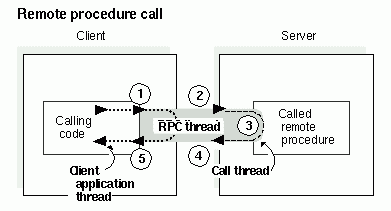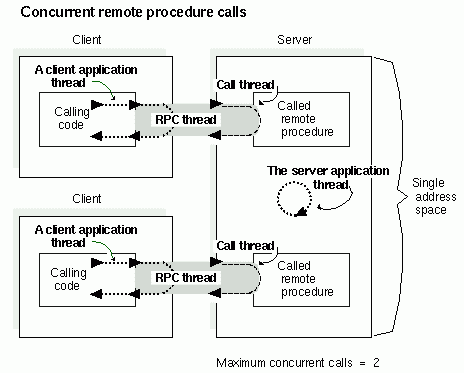
In distributed processing, a call extends to and from client and server address spaces. Therefore, when a client application thread calls a remote procedure, it becomes part of a logical thread of execution known as an RPC thread. An RPC thread is a logical construct that encompasses the various phases of a remote procedure call as it extends across actual threads of execution and the network. After making a remote procedure call, the calling client application thread becomes part of the RPC thread. Usually, the RPC thread maintains execution control until the call returns.
The RPC thread of a successful remote procedure call moves through the execution phases illustrated in the following figure.
Execution Phases of an RPC Thread

The execution phases of an RPC thread in the preceding figure include the following operations:
1. The RPC thread begins in the client process, as a client application thread makes a remote procedure call to its stub; at this point, the client thread becomes part of the RPC thread.
2. The RPC thread extends across the network to the server address space.
3. The RPC thread extends into a call thread, where the remote procedure executes. While a called remote procedure is executing, the call thread becomes part of the RPC thread. When the call finishes executing, the call thread ceases being part of the RPC thread.
4. The RPC thread then retracts across the network to the client.
5. When the RPC thread arrives at the calling client application thread, the remote procedure call returns any call results and the client application thread ceases to be part of the RPC thread.
The following figure shows a server executing remote procedures in its two call threads, while the server application thread listens.
Concurrent Call Threads Executing in Shared Address Space

Note: Although a remote procedure can be viewed logically as executing within the exclusive control of an RPC thread, some parallel activity does occur in both the client and server.
An RPC server can concurrently execute as many remote procedure calls as it has call threads. When a server is using all of its call threads, the server application thread continues listening for incoming remote procedure calls. While waiting for a call thread to become available, DCE RPC server runtimes can queue incoming calls. Queuing incoming calls avoids remote procedure calls failing during short-term congestion. The queue capacity for incoming calls is implementation dependent; most implementations offer a small queue capacity. The queuing of incoming calls is discussed in Topics in RPC Application Development, under the topic of the routing of incoming calls.